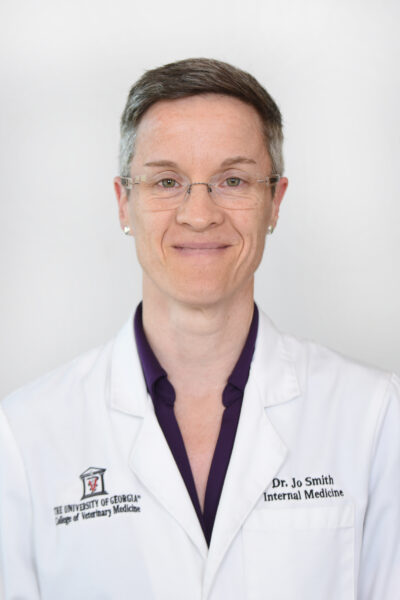The expansion of the Pet Health Center on Classic Campus is set to begin this summer, putting a public face on an internal transformation of the way veterinary students are prepared for careers in general practice.
Funded with a $5.2 million grant from The Stanton Foundation under its Spectrum of Care initiative, the PHC expansion will allow additional faculty to offer more hands-on learning experiences to students in a community-centered setting. That focus will continue through all four years of the DVM curriculum and will include simulated client interactions role-played by fellow students enrolled in the Department of Theatre and Film Studies in the Franklin College of Arts and Sciences.
The goal of an update that is both physical and philosophical is to offer students more practice in providing primary health care that meets the needs of clients including financial, emotional, physical, and cultural contexts. Additionally, students will have the opportunity to refine their skills and confidence in diagnosing and treating diseases of small and large animals commonly seen in a community-based practice.

Dr. Jo Smith, associate professor, Small Animal Department
“The kind of cases we see here (at the Veterinary Teaching Hospital) are not that common in veterinary practice. You get a disproportionate idea of the prevalence of diseases and so that can influence your clinical reasoning when you’re out in practice,” says Dr. Jo Smith, associate professor in Small Animal Internal Medicine. “There’s an old saying that says when you hear hooves think horses not zebras. We see a lot of zebras here, and so another emphasis of Spectrum of Care is trying to increase the exposure to primary practice cases. That is certainly behind the initiative to remodel the pet health center.”
With two more faculty members and 5,000 square feet of additional space, the Pet Health Center will allow students to gain the skill and confidence to perform routine procedures.
Dr. Sara Gonzalez, clinical associate professor of Community Practice, currently oversees three-week clinical rotations for fourth year DVM students at the PHC. “Students are the primary contact points for our clients and patients, stepping into the role of the doctor with our support during their three-week rotation. They practice hands-on, clinical reasoning, and communication skills with their cases, and we emphasize Spectrum of Care topics in our case rounds and discussions.”

Dr. Sara Gonzalez assists a fourth-year veterinary student with a canine exame in the Pet Health Center. (Lawton Harris/UGA CVM)
As important as clinical skills are, communication is the other key component of the Spectrum of Care curriculum. In general practice, a veterinarian must have a clear understanding of a client’s circumstances and their limitations to deliver effective care. Whereas veterinary medicine once focused on a fixed “gold standard of care,” Spectrum of Care acknowledges that the concept of a gold standard differs from one client to another.
Financial concerns leap first to mind when Spectrum of Care is discussed, and teaching students how to determine those limitations is part of a communications component built into the new curriculum.
While practitioners at the VTH are skilled in communicating the costs of treatments delivered within that setting, the very nature of the specialties offered there informs a client of the potential expense that comes with referral for further diagnosis and treatment.

Dr. Andrew Parks, associate dean of Academic Affairs
“Clients already know that they will be making a financial commitment when they come to the teaching hospital, which is not the same as when they go into a small animal or a large animal private practice,” says Dr. Andrew Parks, associate dean of Academic Affairs in the CVM.
But there are other factors that limit a pet owner’s comfort with a treatment plan. They may work two jobs and be unable to bring their pet in as frequently as necessary for treatment. Such a schedule can also interfere with a medication regimen that requires dosing at precise times. Along that same vein, the client may lack reliable transportation to travel to and from the office as often as treatment and follow-up require. They may have a physical disability that impedes frequent travel or makes it difficult to administer medications. The pet’s temperament, too, may dictate treatment methods.
Parks says that instruction has always emphasized how to diagnose and how to treat problems. “But we have seldom dwelled on the relative merits of cost, culture, physical limitations, and outcomes. And we need to emphasize obtaining an understanding of what our clients’ real needs are. So, in other words, that comes first, understanding our clients’ real needs, and then knowing all the options, and then being able to put it in a framework that clients can understand and make the best choices for them and their animals.”
Construction of the expansion at the PHC is slated to begin this summer and last for one year. The first phase will be paving a new client parking lot on the east end of the building. Then the addition will be added on the south side of the building, in the place of the current client parking lot. The final phase will be internal renovations to the existing facility.
Gonzalez said the goal is to keep the PHC open during construction, which will include an enlarged dentistry suite and additional exam rooms with observation rooms for communication training.

